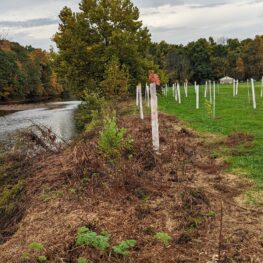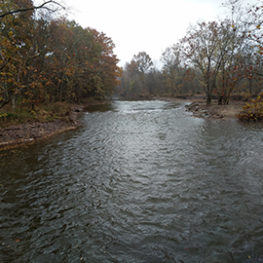Over the past two centuries, activities of people like cutting trees in riparian forests, building dams on rivers, and creating pollution from stormwater runoff in developed areas have had major impacts on the health of streams and rivers. The effects of these practices are being made even worse as climate change is causing bigger storms, more polluted stormwater runoff, and major flooding of our waterways, making restoration a critical component of climate resilience planning. Restoration of damaged stream ecosystems and their surrounding forested riparian buffers are of major importance to protecting human life and property, improving water quality in our rivers, preserving the diversity of fish and wildlife in our streams, and controlling flood impacts associated with climate change. RHA’s science and conservation program is working to restore stream health in the Upper Raritan Watershed Region by planting native trees and shrubs along streams, removing dams and improving instream habitat. Funds from the Cornell-Dubilier Electronics (CDE) Superfund Settlement is allowing RHA to step up these initiatives. These projects complement other RHA initiatives, such as the Budd Lake Watershed Restoration and Protection Plan and River Friendly programs, aimed at addressing stormwater runoff in developed areas.
RHA Announces the Raritan Woods & Waterways Grant Program (Click here)
Riparian Forested Buffer Restoration

Tubes protecting newly planted native trees from deer on the North Branch Raritan River in Bridgewater, NJ.
Forested riparian areas serve critical ecosystem functions in protecting water quality, habitat, and biodiversity in streams. They also absorb the impacts of floodwater from storms, which have become more severe with climate change. In short, we need trees! While the state regulatory requirements for stream buffers in the region range from 50 – 300 feet, RHA’s GIS analysis of buffers indicates the mainstems of the North Branch and South Branch Raritan River and many of the tributaries have long segments where forested buffers have been removed or are unsustainable due to dead or dying trees, lack of tree regeneration, high deer densities, and a predominance of invasive vines and shrubs. Raritan Headwaters has a longstanding commitment to planting trees and restoring forests along our streams including projects completed on Peapack Brook in Peapack-Gladstone, Walnut Brook in Raritan Twp., Holland Brook in Readington Twp., and Mine Brook in Bernardsville. Our current funding from CDE allows us to focus on a major riparian buffer restoration effort along the North Branch Raritan River and its tributaries with a goal of establishing and maintaining 10,000 native trees and shrubs and restoring at least 8 miles of stream buffer in partnership with municipalities, county parks and other public landowners over the next 3 years.
Background on stream buffers and useful tips for planting trees and shrubs along the stream corridor can be found here.
Interested in restoring a riparian buffer in your community? Learn more about the Raritan Woods & Waterways Grant Program.
Dam Removals and Instream Restoration

The Lamington River at Burnt Mills Preserve where RHA and partners removed a dam and restored the river to its original channel in 2019.
Dams were created to impound water along rivers and streams in order to divert water to mills or to create “ponds” for various practical and aesthetic reasons. However, dams have many negative impacts on stream ecosystems and water quality. These include creating a barrier to passage for migratory as well as non-migratory fish species, raising temperatures and sediment retention in the impoundment and downstream, disruption of stream hydrology both upstream and downstream of a dam, liability associated with potential drownings when people are attracted to the impoundment, and downstream flooding due to a dam breach. In 2019, RHA worked with partners to remove a partial dam remaining on the Lamington River and restore the river to its original channel at RHA’s Burnt Mills Preserve. Presently, RHA is utilizing funds from CDE to serve as a partner in exploring the removal of the Klines Mill dam on the North Branch Raritan and Nunns Mill, Rockafellows Mill, and Califon (Coles Mill) dams on the South Branch Raritan. In addition, funding from The Nature Conservancy is allowing RHA to work with partners to initiate feasibility studies and early design plans for the removal of the partially remaining Darts Mill dam on the South Branch Raritan. As a member of the NJ Statewide Dam Removal Partnership, RHA is providing critical information to support others in planning and implementing dam removals throughout the state.
Monitoring the Results of Restoration
As part of its conservation initiatives, RHA is monitoring the impacts of restoration projects on water quality and biodiversity to see what is working and what is not working. RHA’s award-winning stream monitoring program and its trained volunteers collect data on benthic macroinvertebrates, habitat, and chemical parameters before and after restoration project implementation, both upstream and downstream of the project. Analysis of data from several projects will help to demonstrate the benefits of dam removals and riparian restoration, provide information on how future projects may be modified or improved, and justify spending on additional restoration projects.
Interested in planting trees along a stream or taking down a dam? Contact:
Robert Lucas, Restoration Coordinator
Email: rlucas@raritanheadwaters.org
(908) 234-1852 x317
